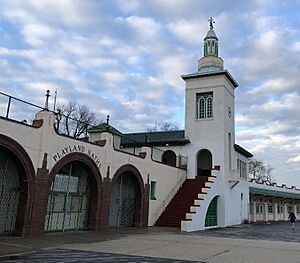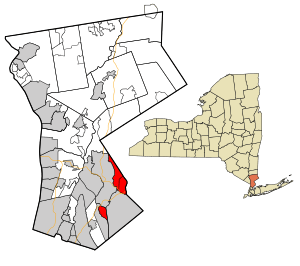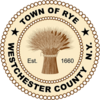Rye (town), New York facts for kids
Quick facts for kids
Rye, New York
|
||
|---|---|---|
| Town of Rye | ||

Playland Park tower
|
||
|
||

Location of Rye (town), New York
|
||
| Country | United States | |
| State | New York | |
| County | Westchester | |
| Government | ||
| • Type | Manager-Council | |
| Area | ||
| • Total | 7.34 sq mi (19.00 km2) | |
| • Land | 6.91 sq mi (17.89 km2) | |
| • Water | 0.43 sq mi (1.10 km2) | |
| Population
(2020)
|
||
| • Total | 49,613 | |
| • Density | 7,181/sq mi (2,773/km2) | |
| Time zone | UTC-5 (Eastern (EST)) | |
| • Summer (DST) | UTC-4 (EDT) | |
| Area code(s) | 914 | |
| FIPS code | 36-119-64320 | |
Rye is a town located in Westchester County, New York, United States. In 2020, about 49,613 people lived here. It's important to know that the Town of Rye is a separate place from the City of Rye.
The Town of Rye includes two villages: Port Chester and Rye Brook. It also contains the Rye Neck part of the village of Mamaroneck. These three areas make up the entire Town of Rye.
Contents
History of Rye Town
The story of Rye Town began on Manursing Island. On June 29, 1660, three settlers from "Grenege" (now Greenwich, Connecticut) bought Manursing Island from the Mohegan Indians. Their names were Thomas Studwell, John Coe, and Peter Disbrow.
In 1661, Peter Disbrow bought more land between the Byram River and Blind Brook. That same year, John Budd joined them. He was an early settler from Long Island and New Haven. These four men bought even more land from the Indians in 1662 and are known as the founders of Rye.
A nearby town called Hastings joined Rye in the 1660s. By 1666, a sale of a house mentioned that it was done "by agreement of the men of Hastings, now called Rye." Both Rye and Hastings are also names of towns in England.
Boundary Changes and Land Ownership
Both Connecticut and New York wanted control over this area. However, the early settlers felt safer under Connecticut's protection. In 1683, Connecticut officially gave Rye to New York. This was part of an agreement that also created the Connecticut Panhandle.
John Budd, one of the founders, bought a large piece of land west of Blind Brook in 1661. This area was called Apawquammis by the Indians. He made several big land purchases that month. In 1666, Budd bought even more land. Other colonists worried that Budd owned too much land and was bringing in too many new settlers. They felt this was "extremely harmful to the town" of Rye.
In 1668, some residents asked the governor to make Budd sell some of his land. But their request failed. Budd and his family continued to sell parts of their land to new settlers. For example, in 1745, John Budd's grandson sold 150 acres to Peter Jay. Peter Jay was the father of John Jay, who later became a very important figure in American history. John Jay was president of the Continental Congress and the first Chief Justice of the United States.
Growth and Development
The town grew over time. It developed Poningo Neck, which is now the main business area of the City of Rye. Later, the Saw Pit area, known today as Port Chester, also grew. Some of the oldest roads, like the Post Road, King Street, and Grace Church Street, were once carriage paths that helped people travel in and out of the area.
The Rye Town Park-Bathing Complex and Oakland Beach is a special place. It was added to the National Register of Historic Places in 2003. Even though it's in the City of Rye, people from the Town of Rye and its villages can use it.
Geography of Rye Town
The Town of Rye covers about 7.3 sqmi (19.0 km2). About 6.9 sqmi (17.9 km2) of this is land, and 0.4 sqmi (1.1 km2) is water.
The Town of Rye is not all connected in one piece. The City of Rye sits in between its different parts. For example, the village of Mamaroneck is to the southwest. The villages of Port Chester and Rye Brook are to the north and northeast. It's important to remember that Rye Town is different from Rye City.
Population and People
| Historical population | |||
|---|---|---|---|
| Census | Pop. | %± | |
| 1790 | 986 | — | |
| 1810 | 1,278 | — | |
| 1820 | 1,342 | 5.0% | |
| 1830 | 1,602 | 19.4% | |
| 1840 | 1,803 | 12.5% | |
| 1850 | 2,584 | 43.3% | |
| 1860 | 4,447 | 72.1% | |
| 1870 | 7,150 | 60.8% | |
| 1880 | 6,576 | −8.0% | |
| 1890 | 9,477 | 44.1% | |
| 1900 | 12,861 | 35.7% | |
| 1910 | 19,652 | 52.8% | |
| 1920 | 25,819 | 31.4% | |
| 1930 | 37,495 | 45.2% | |
| 1940 | 40,135 | 7.0% | |
| 1950 | 32,796 | −18.3% | |
| 1960 | 38,147 | 16.3% | |
| 1970 | 43,234 | 13.3% | |
| 1980 | 38,896 | −10.0% | |
| 1990 | 39,524 | 1.6% | |
| 2000 | 43,880 | 11.0% | |
| 2010 | 45,928 | 4.7% | |
| 2020 | 49,613 | 8.0% | |
| U.S. Decennial Census | |||
In 2000, there were 43,880 people living in the town. There were 15,389 households and 10,818 families. The town had about 6,298 people per square mile.
Most people in Rye Town (71.30%) were White. About 5.14% were Black, and 2.88% were Asian. Around 15.41% were from other races. People of Hispanic or Latino background made up 32.51% of the population.
About 33.6% of households had children under 18 living with them. Most households (54.1%) were married couples. Around 24.3% of households were single people living alone. The average household had 2.82 people.
The median age in the town was 36 years old. About 23.5% of the population was under 18. About 14.0% were 65 years or older.
The median income for a household was $56,675. For families, it was $65,342. The average income per person was $28,948. About 9.8% of the population lived below the poverty line. This included 10.5% of those under 18.
Parks and Recreation
The Town of Rye has two parks for everyone to enjoy.
- Crawford Park is a large park in the village of Rye Brook. It covers about 35.6 acres. You can find soccer fields, a softball field, and open grassy areas here. There's also a playground and a big mansion.
- Rye Town Park/Oakland Beach is located next to Playland Park. It's along Forest Avenue in the City of Rye. This park has 62 acres of grasslands, forests, and open fields. It also has a duck pond and a beach on Long Island Sound.
See also
 In Spanish: Rye (pueblo) para niños
In Spanish: Rye (pueblo) para niños



